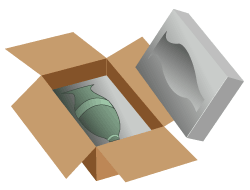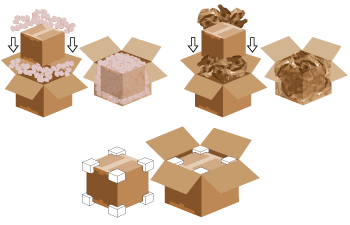Packing & Cushioning Guidelines
Recommended Cushioning:
Foam-in-Bag
Foam-in-place or foam-in-bag pads are formed by a chemical mixture that expands and forms a protective mold around contents.
Foam-in-place or foam-in-bag pads form and mold around any product. These cushions work well to support corners and protect edges.
For maximum effectiveness, the foam-in-place or foam-in-bag must be evenly distributed around the items in order to protect the product. Since this material is offered in varying densities it is important to select the most appropriate foam to meet the requirements of the product. This can range from a low grade void fill for lightweight items to a high-performance cushioning.


Alternate Cushioning:
Double Box
Double-boxing or over-boxing is an effective method of protecting fragile items for shipment through carriers, such as UPS, that use manual and automated distribution systems.
Make sure that the packaging is in good condition and intact. Cracked or broken pieces should be reinforced or repaired. Make sure that the item cannot move in the packaging by wrapping it in bubble wrap and filling void spaces with dunnage material.
Select a new shipping container that is at least six inches (15.24 cm) larger than each of the original box's dimensions. Fill the bottom of the new shipping container with two to three inches (5.08 cm to 7.62 cm) of loose fill (for merchandise up to 10 lbs/4.54 kg), bubble sheeting (for merchandise up to 50 lbs/22.68 kg), foam-in-place, polyethylene foam pads, or other dunnage material.
Place the original manufacturer's box on top of the cushioning material in the center of the shipping container and place cushioning around the remaining five sides. Seal the flaps of the box with heavy shipping tape.
